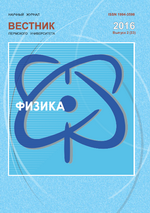Vibrational mechanisms of admixture transport in convective systems
DOI:
https://doi.org/10.17072/1994-3598-2016-2-27-34Abstract
The equations of vibrational convection for non-uniform molecular fluid mixtures have been derived when the diffusion coefficient depends on concentration of components. Equation system is received with the help of the averaging method in the limiting case of high frequencies and small values of amplitude. In a definite sense this one is identical mathematically to well-known equations system of thermal vibrational convection in an approximation of Zen’kovskaya and Simonenko. The problem of concentration field evolution in a plane infinite fluid layer has been solved numerically by the method of finite differences. The modeling situation with homogeneous one-dimensional source distribution of a heavy component on the solid boundary was considered. It was found that the high frequency vibrations can induce mean convective flow in a cavity even in the absence of a temperature inhomogeneity and in the case of weightlessness. At the same time vibrations cause the flow in the form of rolls which occupy the whole volume. The process of admixture ablation into the fluid has been considered for arbitrary oriented vibrations. It has been shown that in dependence on the direction of the vibration axes the process of admixture redistribution passes with various rates. First of all it is determined by the intensity degree of the averaged vibrational flow in a fluid. The modeling calculations were carried out for different values of the non-dimensional parameter which describes the dependence of diffusion coefficient on concentration. Numerical simulation demonstrates that most strong effect of admixture ablation takes place for longitudinal vibrations. On the other hand vibrations which are transversal to layer damps averaged flow. In this case the mass transfer has diffusive character. Also the dependence of mass transfer on diffusion coefficient is most pronounced for tangential vibrations.Received 27.07.2016; accepted 18.08.2016References
Gershuni G. Z., Lyubimov D. V. Thermal vibrational convection. Wiley & Sons, 1998. 358 p.
Zen’kovskaya S. M., Simonenko I. B. Effect of high frequency vibration on convection initiation. Fluid Dynamics, 1966, no. 5. pp. 51–55.
Zavarykin M. P., Zorin S. V., Putin G. F. Experimental study of vibration convection. Doklady Akademii Nauk SSSR, 1985, vol. 281, no. 4, pp. 815–816 (In Russian).
Babushkin I. A., Demin V. A. Vibrational convection in the Hele–Shaw cell. Theory and experiment. Journal of Applied Mechanics and Technical Physics, 2006, vol. 47, no. 2, pp. 183–189.
Demin V. A., Gershuni G. Z., Verkholantsev I. V. Mechanical quasi-equilibrium and thermovibrational convective instability in an inclined fluid layer. International Journal of Heat and Mass Transfer, 1996, vol. 39, no. 9, рр. 1979–1991.
Goldobin D. S., Krausin P. V. Effect of temperature wave on diffusive transport of weakly soluble substances in liquid-saturated porous media. European Physical Journal Plus, 2014, vol. 129, 221. DOI: 10.1140/epjp/i2014-14221-1.
Gershuni G. Z., Zhukhovitskii E. M. Convective stability of incompressible fluids. Jerusalem: Keter Publishing House, 1976. 330 p.
Downloads
Published
How to Cite
Issue
Section
License
Автор предоставляет Издателю журнала (Пермский государственный национальный исследовательский университет) право на использование его статьи в составе журнала, а также на включение текста аннотации, полного текста статьи и информации об авторах в систему «Российский индекс научного цитирования» (РИНЦ).
Автор даёт своё согласие на обработку персональных данных.
Право использования журнала в целом в соответствии с п. 7 ст. 1260 ГК РФ принадлежит Издателю журнала и действует бессрочно на территории Российской Федерации и за её пределами.
Авторское вознаграждение за предоставление автором Издателю указанных выше прав не выплачивается.
Автор включённой в журнал статьи сохраняет исключительное право на неё независимо от права Издателя на использование журнала в целом.
Направление автором статьи в журнал означает его согласие на использование статьи Издателем на указанных выше условиях, на включение статьи в систему РИНЦ, и свидетельствует, что он осведомлён об условиях её использования. В качестве такого согласия рассматривается также направляемая в редакцию справка об авторе, в том числе по электронной почте.
Редакция размещает полный текст статьи на сайте Пермского государственного национального исследовательского университета: http://www.psu.ru и в системе OJS на сайте http://press.psu.ru
Плата за публикацию рукописей не взимается. Гонорар за публикации не выплачивается. Авторский экземпляр высылается автору по указанному им адресу.

